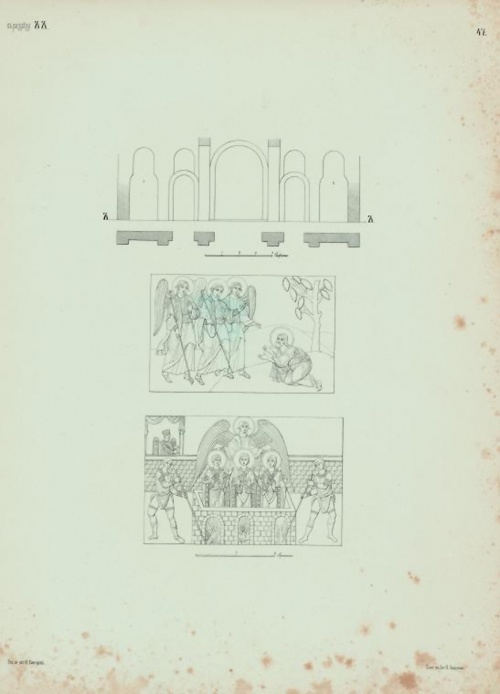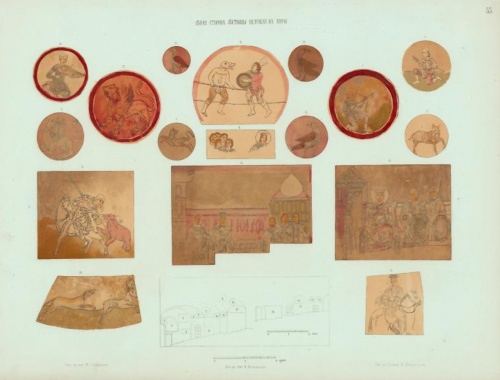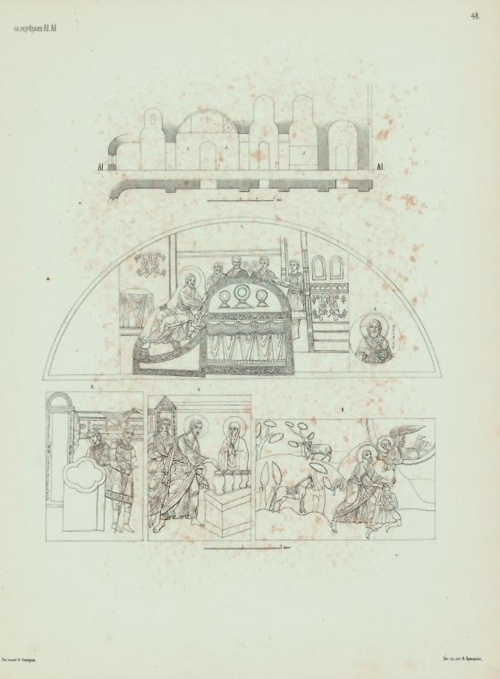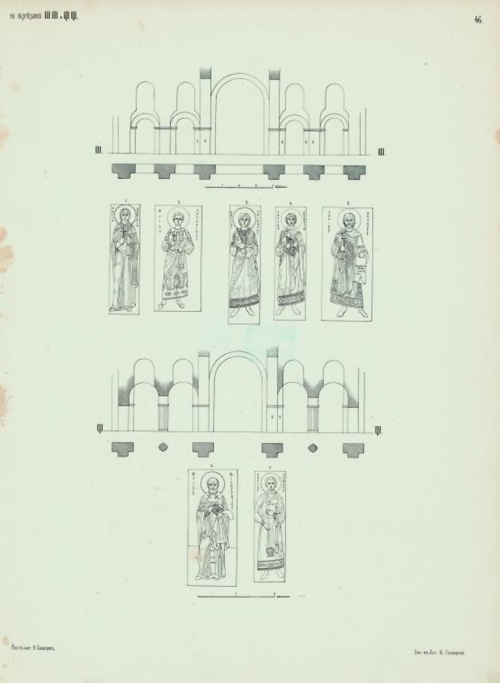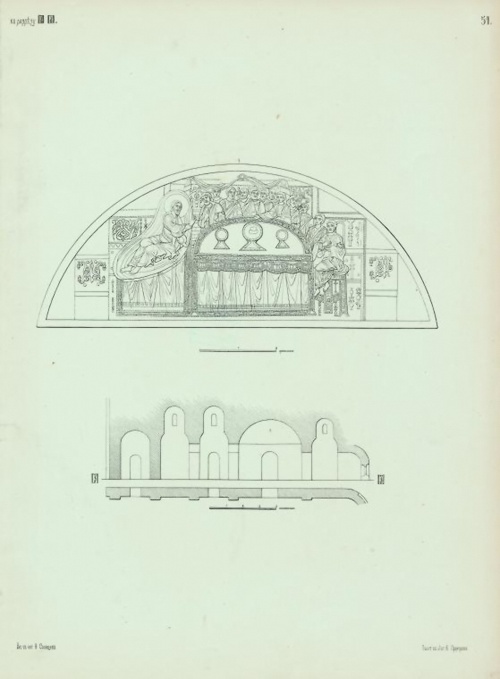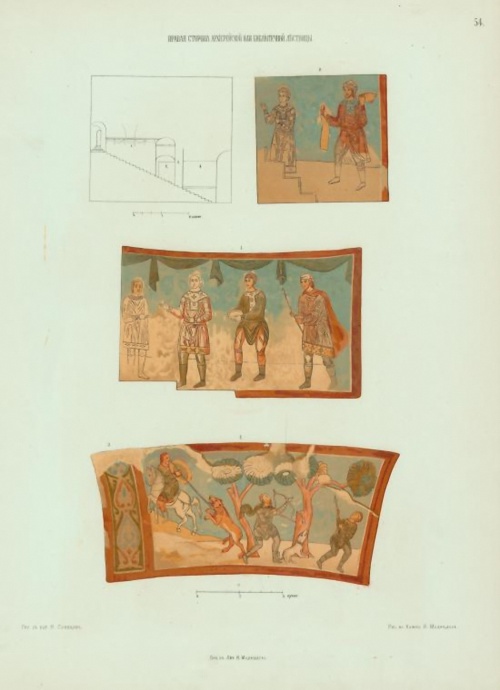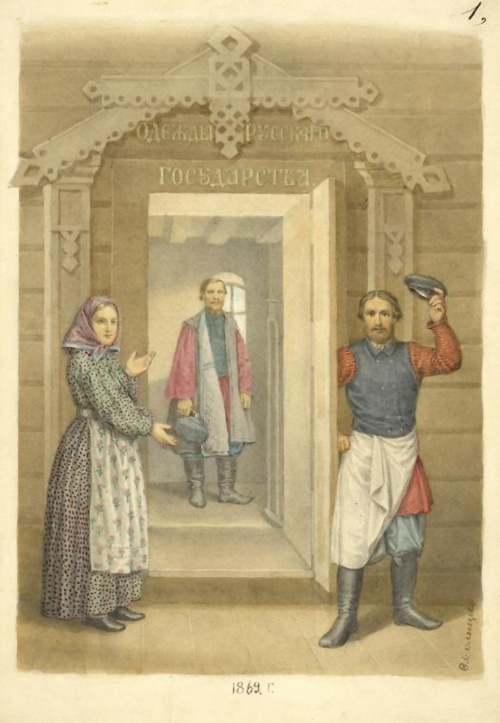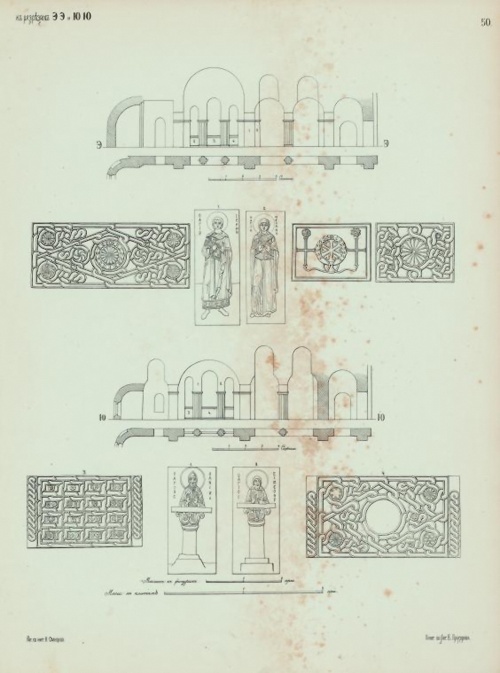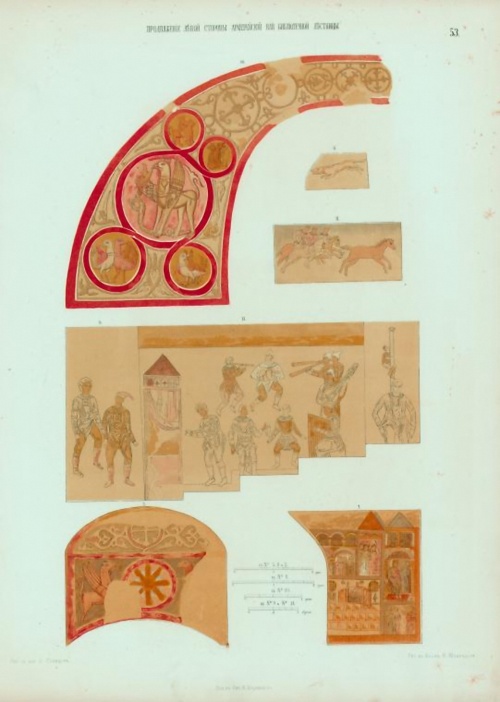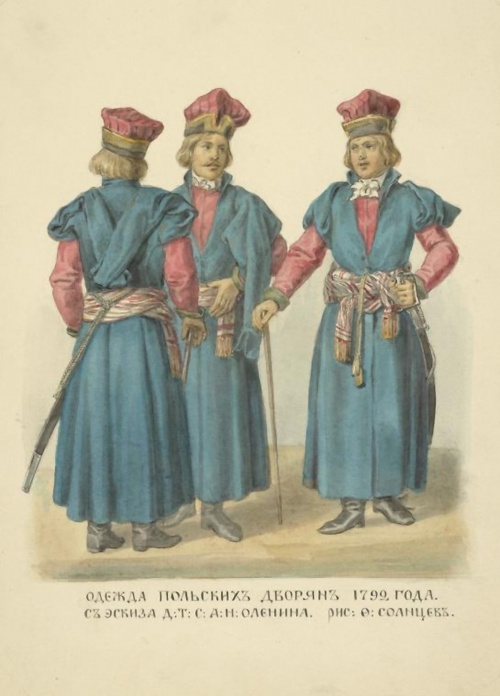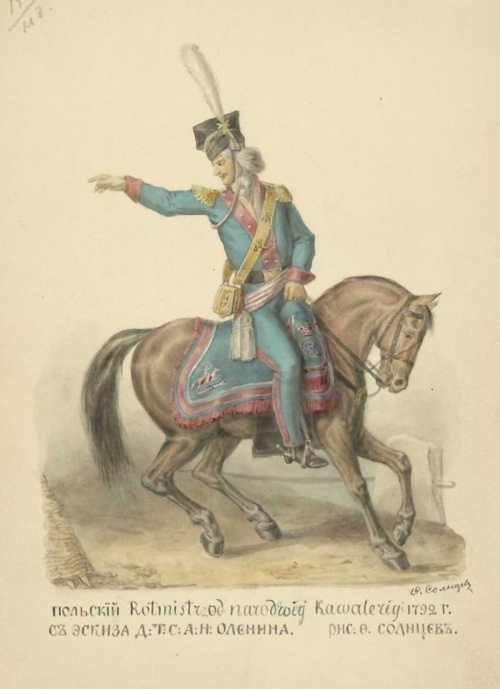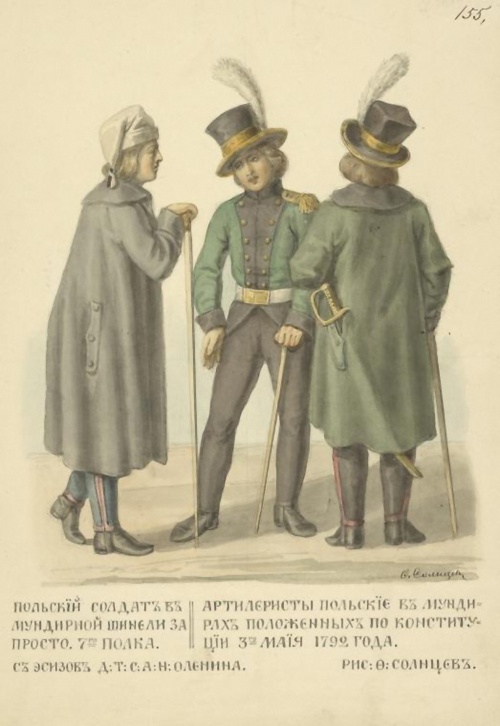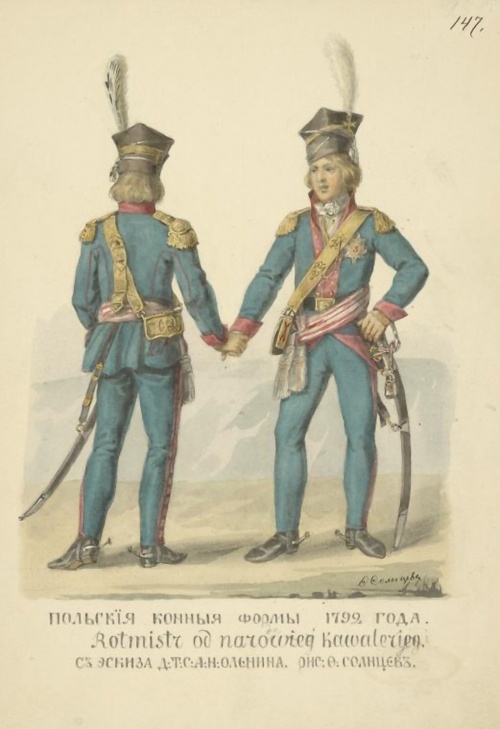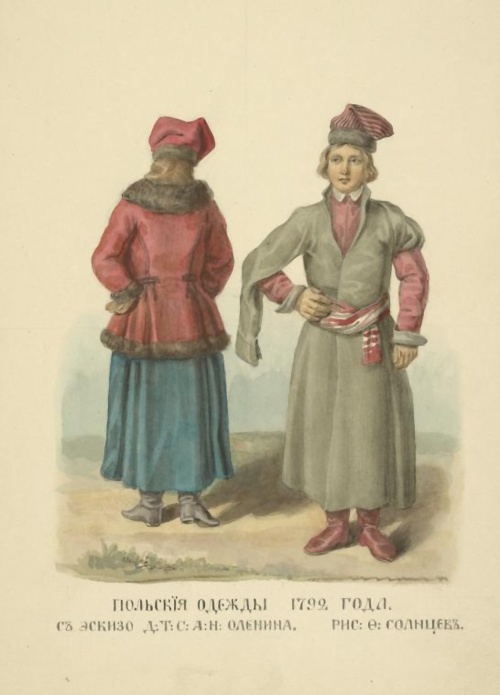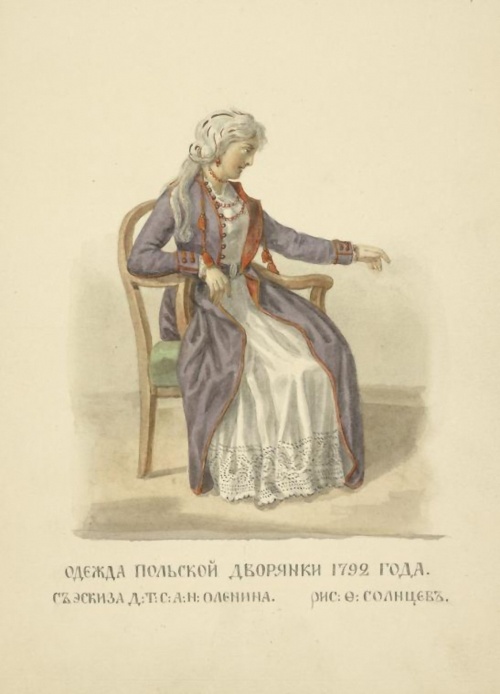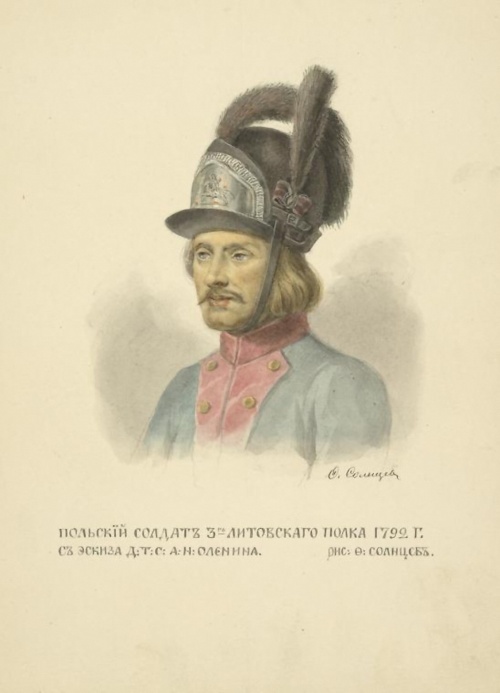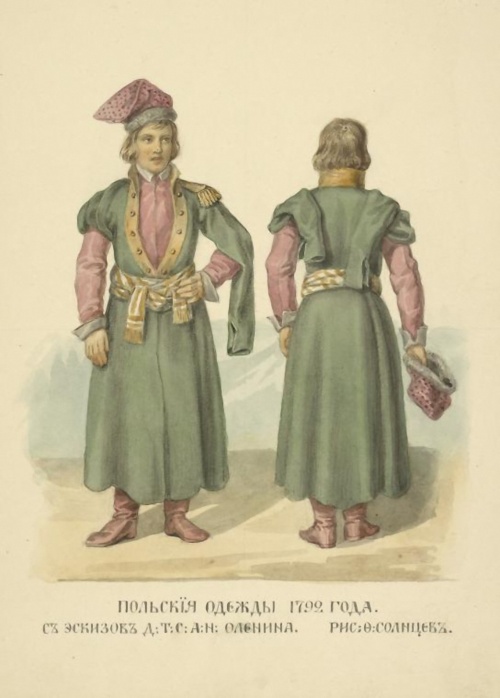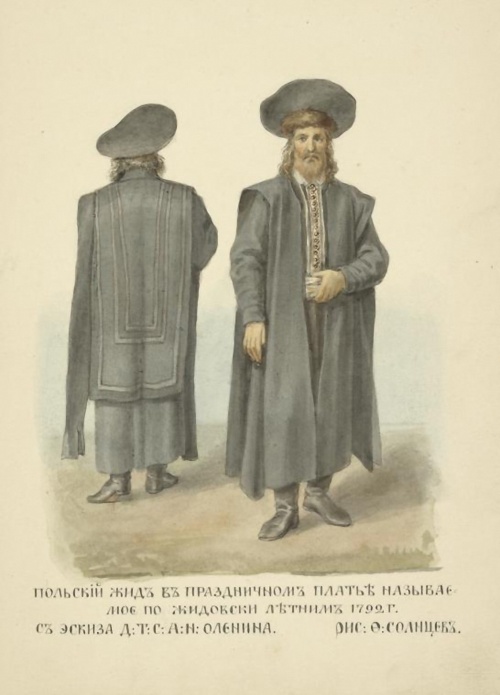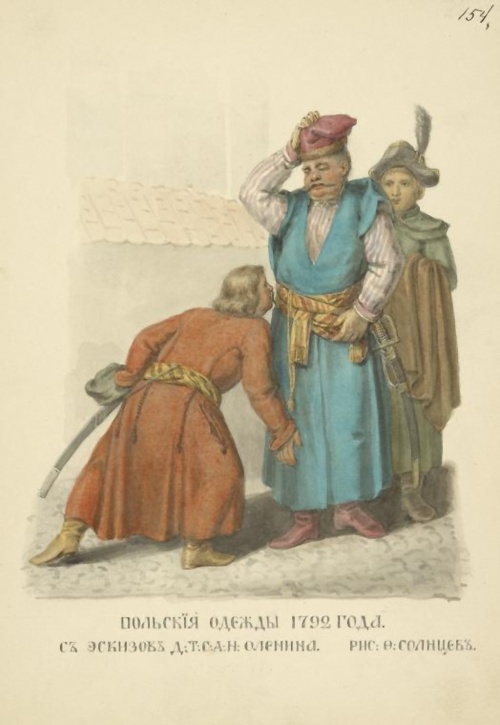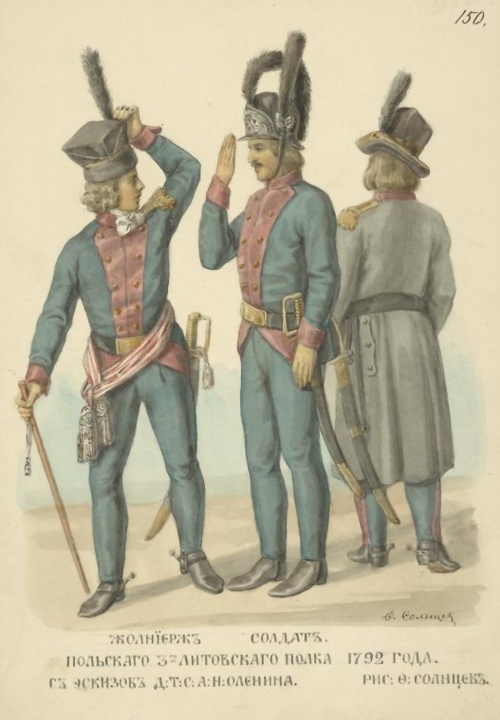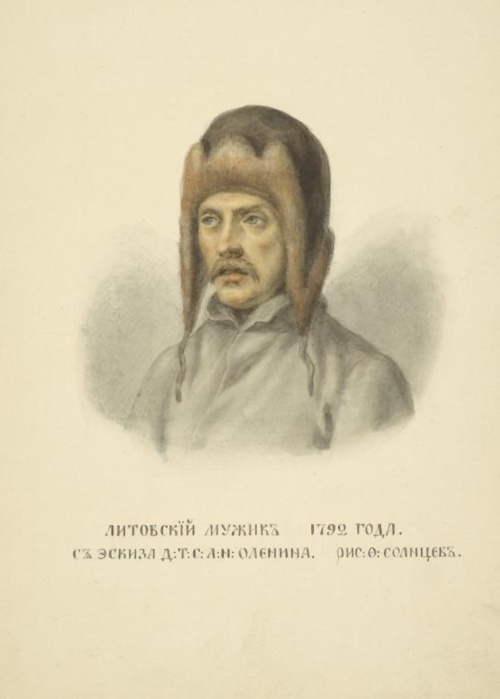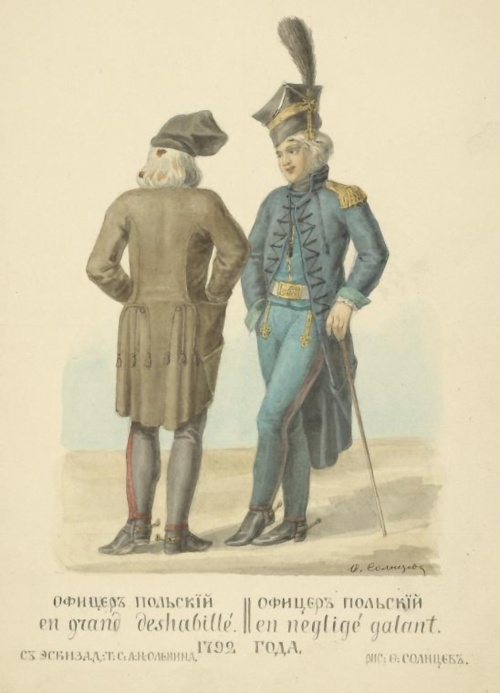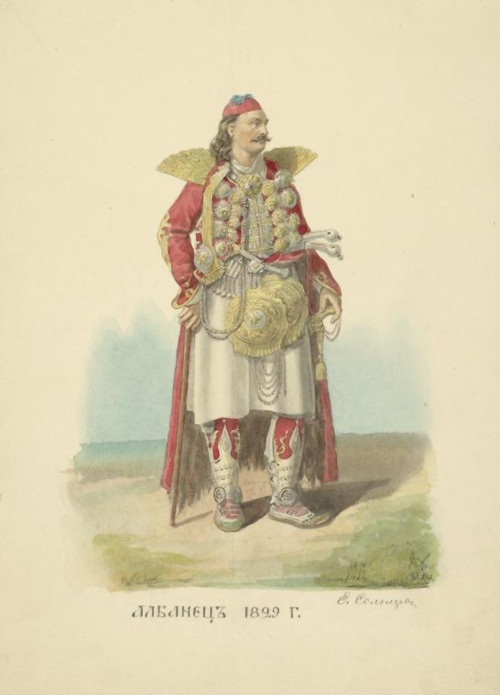Life and works of the artist Fyodor Solntsev (877 works)
Разрешение картинок от 500x655px до 1900x1720px
Russian science owes the works of Solntsev the collection of “Antiquities of the Russian State” and “Kerch and Phanagorian Antiquities”. Based on Solntsev’s drawings, the towers and churches of the Moscow Kremlin were restored, the halls of the Kremlin Palace were decorated. He has the honor of discovering and restoring mosaics and frescoes of St. Sophia of Kyiv, the Assumption Cathedral of Kiev Pechersk Lavra, Dmitrovsky Cathedral in Vladimir.
In 1876 during the celebration of the 50th anniversary of the artistic and archaeological activities of F.G. Solntsev, editor-in-chief of the famous magazine “Russian Antiquity” Mikhail Ivanovich Semevsky said: “Solntsev’s drawings, in scientific and artistic terms, are the pictorial chronicle of Ancient Rus', the source of the revival of the Russian style. And if Karamzin in the chronicles and other archaeographic monuments of our Fatherland found living colors for the style its history; If Pushkin found a living, fresh current in folk tales, with which he renewed the language of Russian poetry, then the artist Solntsev, with his works, awakened in Russian artists a sense of national self-awareness and respect for the images bequeathed to us by our ancestors.”
Fyodor Grigoryevich Solntsev was born on April 14, 1801 in the village of Verkhne-Nikulsky, Mologsky district, Yaroslavl province, into the family of landowner (serf) peasants Count Musin-Pushkin. After the birth of his son Fyodor, his father, Grigory Kondratyevich, left for St. Petersburg and began working as a cashier at imperial theaters. Soon the elder brother, Denis, also moved to the northern capital. Fyodor and his mother Elizaveta Frolovna remained in the village. Thanks to the efforts of his mother, who was a literate woman, he began to learn to read. But studying in general was difficult. It was much more interesting to draw or copy popular prints, play on the bank of a stream,
flowing into the famous Sit River.
When in 1815 the father, as usual, visited the family, they complained to him about a careless child who was only interested in drawing various village and church objects. Grigory Kondratievich, apparently having a good instinct, took the child with him to St. Petersburg. Here, on Admiralteyskaya Square in the house of Count Kutaisov, living with his brother and father, Fyodor Grigorievich began to study arithmetic, French and German, and study a number of general education subjects and also drawing.
While Fyodor Grigorievich was slowly studying with his brother, his father was busy getting him into the Academy of Arts. This happened in the same year, 1815. Having once gone, on the orders of Grigory Kondratievich, to the inspector of academic classes, the famous artist K.I. Golovachevsky, Fyodor Solntsev was immediately included in the number of his own students. In 1815 he was assigned to the first drawing class. Less than six months later, Solntsev found himself in the full-scale class. Having passed into the third age, F.G. Solntsev chose historical and portrait painting as his specialty, and began to work under the guidance of famous Russian painters, professors S.S. Shchukina, A.A. Egorova and A.G. Varnek. Solntsev worked a lot and interestingly, took part in the painting of the Kazan Cathedral. Soon the director of the Imperial Public Library A.N. Olenin, who became the President of the Academy of Arts in 1817, drew attention to the paintings of the aspiring artist. “A lover and connoisseur of antiquities,” widely erudite in matters of literature and art, historian, archaeologist and ethnographer, he attracted the young artist to perform various works and orders, aiming at artistic and archaeological research. A.N. Olenin contributed to the formation and formation of a unique historical painter, an expert in archeology and history of Russia.
In 1829, almost five years after Solntsev graduated from the Academy of Arts, Olenin invited him to work on the publication of a book about Ryazan antiquities.
F.G. Solntsev made drawings of Ryazan antiquities: precious plaques, bars, rings. He later recalled about this work: “Alexei Nikolaevich suggested that I draw “Ryazan antiquities.” I set to work. I had to draw in Alexei Nikolaevich’s office. By the way, I had drawn a plaque, and this drawing was lying on the table. One day, a professor of perspective, M.N., came to see Alexei Nikolaevich. Vorobiev.
Noticing a plaque on the table and mistaking it for a real one, he wanted to move it with his hand, but seeing his mistake, he said: “Is it really drawn!” On this occasion, Alexey Nikolaevich remarked: “Yes, it’s impossible to give better praise to art.”
Work on Ryazan antiquities finally connected the life and work of Fyodor Grigorievich with archeology.
The most important stage in the creative biography of F.G. Solntsev was the 30s of the 19th century. During this time, he worked in Moscow, taking drawings from ancient things stored in the Armory of the Moscow Kremlin and its cathedrals, making watercolor sketches of various views of Moscow. Part These drawings were made for the Russian historian, full member of the Imperial Society of Russian History and Antiquities - Ivan Mikhailovich Snegirev.
In the introductory article to one of them, publisher August Semyon noted:
“Description of the antiquities of the first throne, royal capital of Russia, before
worthy of the greatness of the subject and the reverent attention of the Russian people and the Russian land to the shrines and monuments of Moscow, has long been the common desire of all enlightened people. The study of Russian monuments is the duty of everyone who loves their Fatherland. Their preservation in descriptions and images from accidental death and destruction of time should be revered as a testament of our respect for our ancestors and people's honor.
By a happy accident, the long-desired enterprise found a zealous patron in the former, forever unforgettable mayor of Moscow, Prince D.V. Golitsyna. The description of the monuments of Moscow antiquity was entrusted to the learned expert on Russian antiquities I.M. Snegirev. Curious descriptions of Mr. Snegirev were enriched with drawings by an excellent isographer of Russian antiquities, Academician F.G. Solntseva.
The elegance of the decoration of the drawings and the completeness and clarity of the descriptions aroused the unanimous praise of all our not only Russian, but also foreign newspapers and magazines, which unanimously recognized Monuments of Moscow Antiquity as the first magnificent publication of all those published in Russia to date.”
This joint work of outstanding Russian researchers I.M. Snegirev and F.G. Solntsev, along with “Monuments of Ancient Russian Architecture” by F.F. Richter and “Russian Antiquity” by A.A. Martynov and I.M. Snegirev, laid the foundation for the education of Russian architects in terms of national heritage.
In May 1830, the artist F.G. Solntsev began working on “copying our ancient customs, clothes, weapons, church and royal utensils, belongings, horse harnesses and other items belonging to historical, archaeological and ethnographic information” located in Moscow and kept in the Armory. Solntsev’s work in the Kremlin and in the Armory Chamber was assisted by outstanding public and government figures of the 19th century: Metropolitan of Moscow Filaret (Drozdov), President of the Moscow Palace Office Prince V.V. Yusupov, historian M.P. Pogodin and, of course, A.N. Olenin.
Created by F.G. Solntsev’s collection of drawings of Russian antiquity (and there were more than three thousand of them by the end of the 40s) attracted the attention of Emperor Nicholas I, and he donated about one hundred thousand silver rubles for their publication. Such a donation from the emperor for the publication caused a lively response in public and scientific circles circles in Russia. In the magazine “Moskvityanin”, historian M.P. Pogodin noted that “lovers of Russian antiquity and history bless the royal generosity” and “are looking forward to a magnificent publication.” And 20 years after the publication of “Antiquities of the Russian State” by M.P. Pogodin will write: “The most important and at the same time most magnificent publication of our monuments, archaeological itself, is contained in “Antiquities of the Russian State.” Archeology received a rich benefit in this magnificent publication!”
V.V. Stasov, giving a speech in memory of F.G. Solntsev, highly appreciated “Antiquities of the Russian State.” He said: “The book was to the general taste, it constituted an era in Russian historical consciousness and had a huge influence on the growth of all recent artistic our generations."
Emperor Nicholas I contributed in every possible way to the works of F.G. Solntsev, who brought national traditions to the fore. Among them, certain attention was paid to Russian historical relics.
The enormous work done by Solntsev to restore the Terem Palace of the Moscow Kremlin was highly appreciated by the emperor. He was awarded a diamond ring and made a Knight of the Order of St. Vladimir 4th degree.
Nicholas I gave a number of orders related to Russian antiquity. In Kyiv in 1832, the remains of the Golden Gate were discovered, and since 1835 a special Commission for the Study of Antiquities was in operation. The collected collections entered the Kiev University, where an archaeological museum was opened on March 17, 1837. In 1847, an essay by the Kyiv civil governor was published I.I. Fundukleya “Review of Kyiv”, and in 1848 - “Review of the graves, ramparts and fortifications of the Kyiv province”. Most of the buildings and things were presented in drawings and drawings. The engravings for the book were created based on the drawings of F.G. Solntsev.
It was F.G. Solntsev who had the honor of discovering and restoring the famous frescoes and mosaics of the 11th century. in the Kiev St. Sophia Cathedral, the existence of which was until 1843. no one suspected. “For a long time, ancient images of angels, seraphim and cherubim were noticeable in one of the side compartments of the Cathedral, on the southern side, on the vault, and one could look closely and read Greek inscriptions here,” writes Archpriest I.M. Skvortsov in his book about restoration of the cathedral, published in 1854. But this was only part of the 8-century frescoes, which still had to be looked for on all the walls of the Cathedral.
In 1843, “when traces of fresco images turned out to be in the altar of the monastery of the Venerables Anthony and Theodosius, after an accidental fall of plaster, while he was in Kiev on some business, Academician F.G. Solntsev came up with the idea of the existence of similar images throughout the Yaroslav Church. This idea was confirmed when we tried to clean the whitewash and new tint in different places. Thus, this matter is presented
seemed worthy of the attention of the Highest, it was reported to the Sovereign Emperor, and His Majesty deigned to direct the Holy Synod to find means both for the discovery and renewal of ancient frescoes on all the walls and pillars of the Kiev-Sophia Cathedral. As a result, a Committee was formed to renew this council in all parts of it; Moreover, in accordance with the highest will, the entire pictorial part was entrusted to the main supervision of Academician Solntsev.”
Restoring the frescoes and revealing the mosaics of the St. Sophia Cathedral, F.G. Solntsev copied its paintings with jeweler care. In March 1853, he submitted 80 drawings to the Imperial Russian Archaeological Society for publication. The Archaeological Society agreed to undertake the work of publication, deciding to lithochrome and engrave the drawings. At the same time, the emperor ordered that the publication of new drawings by F.G. Solntsev be a continuation of “Antiquities of the Russian State”. But due to lack of funds, the process of preparing the publication dragged on for many years and began only in 1866. In 1871, the first issue of “Antiquities” - “Kiev St. Sophia Cathedral” - was published.
From 1830 to 1853 F.G. Solntsev traveled a lot to ancient Russian cities, researching and sketching objects and ancient monuments, making ethnographic sketches. “From that time to the present, from the antiquities of the Kerch, Moscow, Trinity-Sergius Lavra, New Jerusalem and their environs, in Ryazan, Vladimir, Kiev, Novgorod, Pskov, Smolensk, Chernigov, Vitebsk, Mogilev and many other district cities, as well as in The sacristy of the Imperial Winter Palace in St. Petersburg was made by Solntsev in watercolors and presented to the Sovereign Emperor up to 2000 drawings. In addition, he is engaged in watercolor painting for other Highest orders, as well as for the newly built Kremlin Palace in Moscow.
Under his supervision, ancient painting was resumed in the Kiev-Uspensky Lavra and Vladimir Demetrius Cathedrals, and ancient frescoes were restored in the Kiev-Sophia Cathedral.
Solntsev for his labors was most mercifully awarded the following orders: St. Vladimir 4th degree, St. Stanislav 2nd degree with crown and St. Anna, 2nd degree, and was awarded an Academician for the painting performed in the program of the Imperial Academy of Arts.
In 1836 F.G. Solntsev was awarded the title of academician for his work.
From 1844 to 1867 he taught icon painting at the St. Petersburg Theological Seminary, for which he received the Order of St. Anna 2nd degree and the Order of St. Vladimir 3rd degree.
In 1858-1866. under his supervision, more than 200 iconostases were made for churches in Western Russian provinces by order of the Ministry of State Property.
He himself made sketches of images, crosses, banners, etc.
Working with monuments of ancient Russian art and household items, studying monuments of Russian antiquity, F.G. Solntsev was constantly in contact with Russian handwritten books, from which he drew the information necessary to date the objects under study, to determine the place of their creation and purpose.
While working in the Moscow Kremlin in the 30s. XIX century with objects of Russian antiquity from the Armory Chamber, the artist’s attention was attracted by such masterpieces of Russian book literature as Svyatoslav’s Collection of 1073, Tsar’s Letters. At the Moscow Synodal Printing House, he drew attention to the unique Yuryev Gospel and early printed books.
F.G. Solntsev copied the most interesting materials: headpieces, capital letters, writing samples from different eras, i.e. everything that could be useful to the artist for understanding, characterizing and reproducing a particular era. In the collection of drawings and watercolors by F.G. Solntsev, stored in the Manuscripts Department of the Russian National Library, turned out to have a whole series of sheets representing ancient Russian book art. It can be assumed that F.G. Solntsev was thinking about systematizing the visual material contained in handwritten and early printed books, and was thinking about creating an album on the history of Russian book ornament.
Since the late 30s, when Emperor Nicholas I took F.G. Solntsev under his patronage, the artist created prayer books and other books of spiritual content for members of the imperial family. One of them was the book “Holidays in the House of the Orthodox Russian Tsar.”
For members of the imperial family, F.G. Solntsev also wrote: Prayer book for Empress Alexandra Feodorovna, wife of Nicholas I; Prayer book for Empress Maria Alexandrovna, wife of Alexander II; Prayer books to guardian angels for the Grand Duchesses Maria Nikolaevna, Olga Nikolaevna and Maria Alexandrovna; Lives of Selected Saints; “Holidays in the House of the Orthodox Russian Tsar”; Life of Sergius of Radonezh; Service to St. Mary Magdalene; “Russian saints, intercessors before God for the Tsar and Holy Rus'”; "Significant days in the House of Emperor Alexander III."
For several years F.G. Solntsev often visited the house of M.P. Volkonskaya, the daughter-in-law of the head of the Palace Chancellery, Chief Marshal P.M. Volkonsky, who took care of the artist after the death of A.N. Olenin. Artists gathered in Maria Petrovna’s house,
composers, among them professor N.I. Pokhvisnev, L. Kikina, L. Lvov, M.A. Mezhakova, P.V. Basin. In the circle of M.P. Volkonskaya in the 50s of the 19th century. under the leadership of Solntsev and with his direct participation, the handwritten book “Prayer Book with the Monthly Word” was created.
They wrote about this handwritten book in the magazine “Capital and Estate”, paying attention to the front Monthly, located at the end of the book. These are images of saints, as well as lordly and twelfth holidays. “You can imagine how much work it took, for example, to place less than four inches high and about three inches wide - an image of the daily saints celebrated throughout the month. To highlight the faces and vestments of half-inch figures, it was necessary to use a magnifying glass and have a real reserve of patience, and, with all possible diligence, for about two or three months it was impossible to complete the table with all the saints of thirty days and the images of the twelve holidays that were part of them.
By order of Princess L.N. Menshikova, F.G. Solntsev created a unique, exceptionally beautiful handwritten book “The Gospel of John.” Academicians G.G. Gagarin and Premazzi worked on the book together with Solntsev.
The logical result of turning to the Russian manuscript tradition was the creation in the early 60s. XIX century on the instructions of the Holy Synod of the Great Holy Saints.
When preparing the Saints, the artist used nine iconographic originals from the 14th - 15th centuries. and performed the work of a historian and ethnographer. He also used many visual images - icons, drawings, his own drawings. In 1866, the Saints were printed. They consisted of 12 sheets, 48 weeks in each, and each week had 100 figures of saints Nestor Kukolnik, anticipating the release of the Saints, wrote that “the publication would be of great benefit to artists when they perform church painting.” The Solntsevsky Saints “represented a whole reference lexicon, an archaeological museum.”
It became quite logical for F.G. Solntseva worked on the design and illustration of various printed publications - books and magazines - using the principles of design of Russian handwritten books.
In the 40s, while working in Kiev, the artist met Metropolitan Philaret (Gumilyovsky). This acquaintance grew into close cooperation. For the works undertaken by Philaret, F.G. Solntsev completed more than 400 drawings. Metropolitan Philaret’s works were repeatedly republished in the second half. XIX - early XX centuries and all the time they came out with illustrations by F.G. Solntsev. Many of these illustrations were used for other publications carried out by order of the Holy Synod. F.G. Solntsev made drawings for various kinds of publications dedicated to saints glorified by the Russian Orthodox Church many times Among them are illustrations created at the request of I.P. Khrushchov for his books about holy ascetics published in the “People’s Readings” series. Drawings by F.G. Solntsev were used in the re-release of “Reflections on the Divine Liturgy” by N.V. Gogol.
The love for Russian history, for “Russian antiquities” brought F.G. together and became friends. Solntseva with M.I. Semevsky – editor of the magazine “Russian Antiquity”. For more than 30 years (until his death), the artist created headers, vignettes and endings for the design of this magazine.
F.G. Solntsev tried to instill a feeling of love for the Old Russian book tradition in his students, among whom was A.P. Ryabushkin. Together they wrote congratulatory addresses, designing them in the Russian style. A.P. Ryabushkin independently created several handwritten books. Old Russian handwritten tradition and handwritten book tradition, the development of which in the 19th century. contributed to F.G. Solntsev, contributed to the fact that Russian artists began to create handwritten books, including V.M. Vasnetsov, M.V. Nesterov, D.S. Stelletsky.
In 1876, the fiftieth anniversary of the artistic and archaeological activity of F.G. was solemnly celebrated in St. Petersburg. Solntsev.From the Imperial Archaeological Society, F.G. Solntsev received a large gold medal embossed on the occasion of the 50th anniversary of artistic and archaeological activity with his portrait. And in the magazine “Russian Antiquity” M.I. Semevsky published the artist’s memoirs
“My life and artistic and archaeological works.” In November 1886, the Academy of Arts celebrated the 50th anniversary of F.G. Solntsev receiving the title of academician.
Little is known about the last 15 years of the artist’s life and work.
And these years were full of daily painstaking work for the Synod and the Synodal Printing House, for the magazine “Russian Antiquity”, for various book publishing houses, and fulfilling private orders. During these years, Solntsev continued to carry out extensive work as a trustee for scholarship holders from state peasants - students at the Imperial Academy of Arts.
Solntsev worked until the very last day, until his death.
In the “Formular list of the service of a former member of the Imperial Academy of Arts for the compilation of a complete collection of archaeological and ethnographic drawings of a professor and honorary free associate of the Academy,” the last entry made in 1892 reads: “He died by the will of God.”
The artist was buriedwith honors at the Volkov Cemetery.
